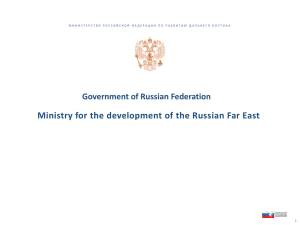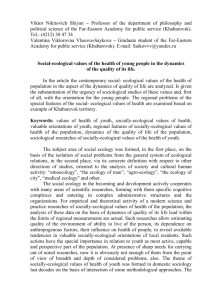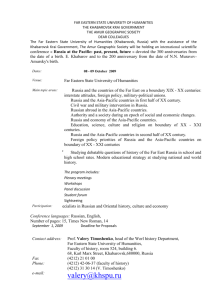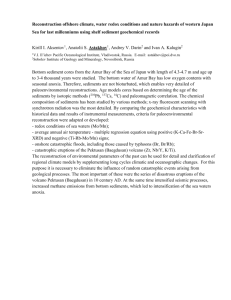Khabarovsk
advertisement
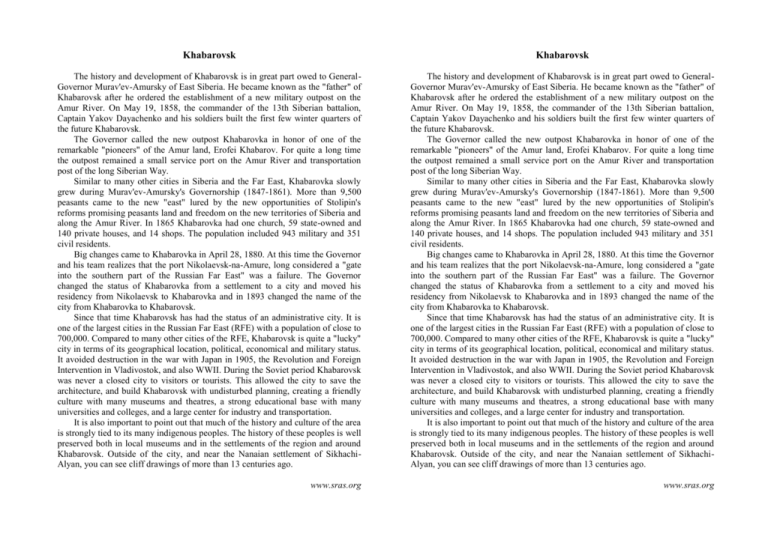
Khabarovsk Khabarovsk The history and development of Khabarovsk is in great part owed to GeneralGovernor Murav'ev-Amursky of East Siberia. He became known as the "father" of Khabarovsk after he ordered the establishment of a new military outpost on the Amur River. On May 19, 1858, the commander of the 13th Siberian battalion, Captain Yakov Dayachenko and his soldiers built the first few winter quarters of the future Khabarovsk. The Governor called the new outpost Khabarovka in honor of one of the remarkable "pioneers" of the Amur land, Erofei Khabarov. For quite a long time the outpost remained a small service port on the Amur River and transportation post of the long Siberian Way. Similar to many other cities in Siberia and the Far East, Khabarovka slowly grew during Murav'ev-Amursky's Governorship (1847-1861). More than 9,500 peasants came to the new "east" lured by the new opportunities of Stolipin's reforms promising peasants land and freedom on the new territories of Siberia and along the Amur River. In 1865 Khabarovka had one church, 59 state-owned and 140 private houses, and 14 shops. The population included 943 military and 351 civil residents. Big changes came to Khabarovka in April 28, 1880. At this time the Governor and his team realizes that the port Nikolaevsk-na-Amure, long considered a "gate into the southern part of the Russian Far East" was a failure. The Governor changed the status of Khabarovka from a settlement to a city and moved his residency from Nikolaevsk to Khabarovka and in 1893 changed the name of the city from Khabarovka to Khabarovsk. Since that time Khabarovsk has had the status of an administrative city. It is one of the largest cities in the Russian Far East (RFE) with a population of close to 700,000. Compared to many other cities of the RFE, Khabarovsk is quite a "lucky" city in terms of its geographical location, political, economical and military status. It avoided destruction in the war with Japan in 1905, the Revolution and Foreign Intervention in Vladivostok, and also WWII. During the Soviet period Khabarovsk was never a closed city to visitors or tourists. This allowed the city to save the architecture, and build Khabarovsk with undisturbed planning, creating a friendly culture with many museums and theatres, a strong educational base with many universities and colleges, and a large center for industry and transportation. It is also important to point out that much of the history and culture of the area is strongly tied to its many indigenous peoples. The history of these peoples is well preserved both in local museums and in the settlements of the region and around Khabarovsk. Outside of the city, and near the Nanaian settlement of SikhachiAlyan, you can see cliff drawings of more than 13 centuries ago. The history and development of Khabarovsk is in great part owed to GeneralGovernor Murav'ev-Amursky of East Siberia. He became known as the "father" of Khabarovsk after he ordered the establishment of a new military outpost on the Amur River. On May 19, 1858, the commander of the 13th Siberian battalion, Captain Yakov Dayachenko and his soldiers built the first few winter quarters of the future Khabarovsk. The Governor called the new outpost Khabarovka in honor of one of the remarkable "pioneers" of the Amur land, Erofei Khabarov. For quite a long time the outpost remained a small service port on the Amur River and transportation post of the long Siberian Way. Similar to many other cities in Siberia and the Far East, Khabarovka slowly grew during Murav'ev-Amursky's Governorship (1847-1861). More than 9,500 peasants came to the new "east" lured by the new opportunities of Stolipin's reforms promising peasants land and freedom on the new territories of Siberia and along the Amur River. In 1865 Khabarovka had one church, 59 state-owned and 140 private houses, and 14 shops. The population included 943 military and 351 civil residents. Big changes came to Khabarovka in April 28, 1880. At this time the Governor and his team realizes that the port Nikolaevsk-na-Amure, long considered a "gate into the southern part of the Russian Far East" was a failure. The Governor changed the status of Khabarovka from a settlement to a city and moved his residency from Nikolaevsk to Khabarovka and in 1893 changed the name of the city from Khabarovka to Khabarovsk. Since that time Khabarovsk has had the status of an administrative city. It is one of the largest cities in the Russian Far East (RFE) with a population of close to 700,000. Compared to many other cities of the RFE, Khabarovsk is quite a "lucky" city in terms of its geographical location, political, economical and military status. It avoided destruction in the war with Japan in 1905, the Revolution and Foreign Intervention in Vladivostok, and also WWII. During the Soviet period Khabarovsk was never a closed city to visitors or tourists. This allowed the city to save the architecture, and build Khabarovsk with undisturbed planning, creating a friendly culture with many museums and theatres, a strong educational base with many universities and colleges, and a large center for industry and transportation. It is also important to point out that much of the history and culture of the area is strongly tied to its many indigenous peoples. The history of these peoples is well preserved both in local museums and in the settlements of the region and around Khabarovsk. Outside of the city, and near the Nanaian settlement of SikhachiAlyan, you can see cliff drawings of more than 13 centuries ago. www.sras.org www.sras.org
